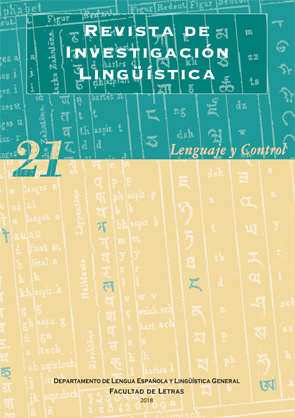The euphemism as a mechanism of manipulation in the written press
Abstract
This work has the euphemism as object and the manipulative use that the written press makes of it. Appear the necessity to continue emphasizing this type of malicious uses of language so that society can be alert at all times to the situation. To give an account of the reality there has made a corpus of euphemisms collected from the Spanish press of the 21st century (2000 to the present). After their analysis, which has followed the methodology of analysis of discourse and critical analysis of the discourse, it has become clear that the written press makes use of euphemisms with manipulative fines (reality of reference, the referent and the individual). Moreover, not only reproduces the euphemisms that came to it from the different spheres of society, but also maintains and perpetuates them.
Downloads
-
Abstract3214
-
PDF (Español (España))5895
References
ALBELDA, M. (2010) «Atenuación, eufemismos y lenguaje políticamente correcto», Aleza, M: Normas y usos correctos en el español actual, págs. 341-374.
BENVENISTE, E. (1979): «Euphémismes anciens et modernes», Problèmes de linguistique générale, Vol. I, págs. 308-314. Paris: Gallimard
BRUNEAU, Ch. (1952): «Euphémie et euphémisme» VV.AA., Festgabe Ernst Gamillscheg, Tubing: Max Niemeyer, págs. 11-23.
CALSAMIGLIA, H. y TUSÓN, A. (2012): Las cosas del decir. Barcelona: Ariel.
CASAS, M. (1986): La interdicción lingüística: mecanismos del eufemismo y disfemismo. Cádiz: Servicio de publicaciones, Universidad.
FUENTES, C. y ALCAIDE, E. (2007): La argumentación lingüística y sus medios de expresión. Madrid: Arco Libros.
GALLUD, E. (2005): «El eufemismo como instrumento de manipulación social», Comunicación y hombre, no. 1, págs. 120-129.
GRICE, P. (1975): «Logic and conversation», en Syntax and Semantics, Vol. 3, Speech Acts. Nueva York: Academic Press, págs. 45-47.
GRIJELMO, A. (2008): El estilo del periodista. Madrid: Taurus.
GUITART, M. (2005): Discurso parlamentario y lenguaje políticamente correcto. Madrid: Congreso de los Diputados.
LÁZARO CARRETER, F. (1974): Diccionario de términos filológicos, 3ª ed. Madrid: Gredos.
LÁZARO CARRETER, F. (1990): «El idioma del periodismo, ¿lengua especial?)», Asterisco, no. 2.
MONTERO, E. (1981): El eufemismo en Galicia: [su comparación con otras áreas romances]. Santiago de Compostela: Universidade de Santiago de Compostela.
MUNTEANO, M. (1953): «Les implications esthétiques de l’euphémisme en France au XVIII siècle», Cahiers de l’Association Internationale des Etudes françaises, no. 3-4-5, págs. 153-166.
NÚÑEZ CABEZAS, A. (2001): «El eufemismo y las fórmulas de evasión en el lenguaje político español», Isla de Arriarán, no. XVII, págs. 419-428.
RODRÍGUEZ GONZÁLEZ (1991): Prensa y lenguaje político. Madrid: Ed. Fundamentos
SECO, M. (2002): «La manipulación de las palabras» Boletín del Instituto de Estudios Giennenses, no. 180, págs. 7-18
SENABRE, R. (1971): «El eufemismo como fenómeno lingüístico» Boletín de la Real Academia Española, no. 51, págs. 175-189.
VAN DIJK, T. (2009). Discurso y poder. Barcelona: Gedisa.
ZUMTHOR, P. (1953): «Euphémisme et rhétorique au Moyen Age» Cahiers de l’Association Internationale des Etudes françaises, no. 3-5, págs. 177-184.
The works published in this magazine are subject to the following terms:
1. The Publications Service of the University of Murcia (the publisher) preserves the economic rights (copyright) of the published works, and favors and allows the reuse of same under the license of use indicated in point 2.
2. The papers are published in the electronic edition of the magazine under a Creative Commons Attribution-NonCommercial-NoDerivative 3.0 Spain license (legal text). Papers may be copied, used, disseminated, transmitted and publicly exhibited if the following requirements are met: i) The authorship and the original source of its publication (magazine, editorial and URL of the work) must be cited; ii) The works cannot be used for commercial purposes; iii) The existence and specifications of this user license must be explicitly mentioned.
3. Self-archiving conditions. Authors can electronically disseminate pre-print versions (version before being evaluated) and / or post-print versions (version evaluated and accepted for publication). This makes possible its circulation and diffusion earlier and with it a possible increase in its citation and reach among the academic community. RoMEO color: green.









